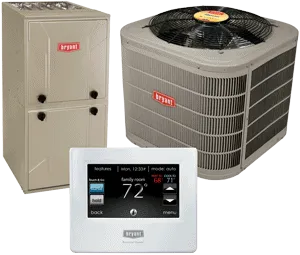Adams Heating & Cooling
HVAC Experts You Can Trust
Serving Tuscaloosa, AL, Birmingham, AL, and surrounding areas since 1982

Signs Your Home Has Poor Indoor Air Quality
Is Your Home’s Air Making You Sick?
Have you ever felt stuffy, fatigued, or experienced unexplained allergies, coughing, or respiratory issues while indoors? These could be signs that the air quality in your home is not optimal. While we often hear about outdoor air pollution and its impact on health, the quality of the air we breathe inside our homes can be just as important — sometimes even more so.
Indoor air quality (IAQ) refers to the condition of the air inside buildings and homes, and it can be influenced by a range of factors, from allergens and pollutants to humidity levels and ventilation. Poor IAQ can lead to a variety of health problems, especially for vulnerable groups like children, the elderly, or those with pre-existing respiratory conditions like asthma.
Common symptoms of poor IAQ include:
Fatigue or unexplained tiredness
Frequent headaches
Coughing, sneezing, or wheezing
Irritated eyes, throat, or skin
Shortness of breath
Increased allergy symptoms (e.g., congestion, itchy eyes)
Dizziness or lightheadedness
These symptoms may appear or worsen when you're indoors, indicating that the quality of the air in your home may be contributing to your discomfort. Many factors can cause poor indoor air quality, including:
Dust, pet dander, and mold
Chemical pollutants from cleaning products, paints, and air fresheners
Excessive humidity or dryness
Poor ventilation, which can trap pollutants indoors
Cigarette smoke or cooking fumes
Building materials that release harmful gases like formaldehyde
It's easy to overlook indoor air quality, as it’s not something we can see or immediately notice, but the impact it has on our health can be significant over time.
Why Good Indoor Air Quality Matters
Good IAQ is essential not only for preventing health issues but also for maintaining comfort in your living space. Clean, fresh air supports better sleep, improves concentration and productivity, and contributes to an overall sense of well-being. Moreover, improving your indoor air quality can help reduce the risks of chronic respiratory diseases, allergies, and even more serious conditions like heart disease.
Steps You Can Take to Improve IAQ
If you suspect that your home's air quality could use a boost, there are several steps you can take to make the air in your home healthier:
Increase Ventilation
Ensure that your home is properly ventilated by opening windows when possible, using exhaust fans, or installing an air exchange system to bring in fresh air and remove stale air. Good ventilation helps to reduce humidity, disperse pollutants, and improve overall air quality.
Regular Cleaning
Dust and vacuum regularly to reduce dust, pet dander, and other allergens. Consider using a vacuum cleaner with a HEPA filter for better dust control. Regular cleaning can significantly reduce airborne particles and allergens that may cause respiratory issues or allergies.
Control Humidity
Use dehumidifiers in damp areas like basements to prevent mold growth. Maintaining humidity levels between 30-50% can help reduce dust mites and mold. Proper humidity control also reduces the potential for health problems associated with excessive moisture in the air.
Air Purifiers
Invest in a high-quality air purifier with a HEPA filter to remove airborne particles like dust, pollen, and pet dander. Some air purifiers also have activated carbon filters that help reduce odors and chemicals, further enhancing indoor air quality.
Remove Toxic Chemicals
Choose non-toxic cleaning products and avoid using aerosol sprays, which can release harmful chemicals into the air. Be mindful of any construction materials or furnishings that may off-gas harmful substances, such as formaldehyde or volatile organic compounds (VOCs).
Houseplants
Some indoor plants, like peace lilies, spider plants, and aloe vera, can naturally improve air quality by absorbing carbon dioxide and releasing oxygen. Certain plants also have the ability to filter out common indoor air pollutants, making your living space healthier.
Regular HVAC Maintenance
If you use air conditioning or heating systems, change filters regularly and have your HVAC system inspected to ensure that it’s working efficiently and not circulating pollutants. Proper maintenance helps improve air quality and ensures the system is operating at its best.
Check for Mold
Inspect areas that are prone to moisture, such as bathrooms and basements, for signs of mold or mildew, and address any water leaks promptly. Mold can affect both air quality and health, so it's important to catch it early and take action to prevent its spread.
By recognizing the signs of poor indoor air quality and taking proactive steps to improve it, you can significantly enhance your living environment. A clean, well-ventilated home not only feels more comfortable but also supports the health and well-being of everyone who lives there.
Common Signs of Poor Indoor Air Quality
Indoor air quality (IAQ) is often an overlooked factor that can have a significant impact on your health and overall comfort. Many people may not realize that the air inside their homes can be just as polluted, if not more so, than the air outdoors. The good news is that recognizing the signs of poor IAQ early can help you take proactive steps to address potential issues before they affect your well-being. Below are some common physical symptoms and environmental indicators that could signal your indoor air quality needs improvement.
Physical Symptoms:
Your body is often the first to react when the air in your home becomes compromised. If you or your family members experience any of the following symptoms, especially if they worsen indoors, it may be a sign that the air quality in your home needs attention.
Unexplained Allergies or Respiratory Issues:
Respiratory problems can often be triggered by allergens or pollutants in the air. If you or others in your home experience symptoms such as sneezing, coughing, or difficulty breathing, these may be linked to poor air quality.
Sneezing, Coughing, or Wheezing: These symptoms can become worse when indoors, especially in rooms with poor airflow or where allergens like dust, pet dander, or mold spores are present.
Nasal Congestion or Runny Nose: Constant congestion or a runny nose that seems to clear up when you leave the house could point to an indoor air quality issue, particularly if the symptoms persist during colder months when homes are sealed tightly.
Itchy, Watery Eyes: Indoor allergens, such as pollen or dust mites, can irritate the eyes, causing them to itch, water, or burn.
Shortness of Breath, Particularly Indoors: Difficulty breathing or a feeling of tightness in the chest that worsens when you're at home might be an indication of pollutants such as mold spores, dust, or tobacco smoke in the air.
Persistent Headaches or Fatigue:
Long-term exposure to poor indoor air can cause headaches, chronic fatigue, and other cognitive or physical symptoms.
Frequent Headaches or Migraines: If you find that you experience headaches regularly, especially when you're indoors, this could be a sign that pollutants like volatile organic compounds (VOCs), which are released from cleaning products, furniture, or air fresheners, are affecting you.
Chronic Fatigue or Feeling Tired After Rest: Constantly feeling fatigued or having low energy despite a full night's sleep may be due to pollutants or poor air circulation. Lack of proper ventilation and the buildup of CO2 can leave you feeling sluggish and drained.
Dizziness or Lightheadedness: A sense of dizziness or lightheadedness, especially in rooms with poor airflow or during activities that increase the use of appliances (like cooking or heating), may indicate that the air quality is affecting your nervous system.
Environmental Indicators:
In addition to physical symptoms, certain environmental cues within your home can be key indicators that your indoor air quality is compromised. These signs, if left unchecked, can also lead to health issues over time.
Musty Odors:
A musty, damp smell in your home is often a clear signal that there are moisture problems, potentially leading to mold or mildew growth.
Damp, Earthy Smell: A persistent musty odor in areas such as bathrooms, basements, or kitchens can indicate the presence of mold or mildew. These fungi thrive in areas with high humidity or water leaks, and the spores they release can cause respiratory issues and allergic reactions.
Lingering Odors: Odors from cleaning products, cooking, or other activities should dissipate fairly quickly with proper ventilation. If you notice that odors linger in your home or even seem to get worse, it may indicate poor air circulation or the buildup of VOCs in the air that can’t escape.
Excessive Dust Buildup:
While a little dust is inevitable, large amounts of dust accumulating in your home may be a sign that your air quality is poor, particularly if you clean regularly and still notice dust reappearing quickly.
Visible Dust on Furniture and Electronics: If you find yourself dusting frequently, or notice thick layers of dust on your furniture, shelves, or electronics, it may be due to poor filtration or ventilation systems. Dust can carry allergens like pet dander and pollen, which contribute to respiratory issues.
Frequent Dusting Despite Regular Cleaning: If you’re constantly battling dust buildup even though you clean regularly, it may be a sign that your HVAC system’s filters are clogged or that your home’s air circulation isn’t efficient enough to remove dust and other airborne particles.
Condensation on Windows:
Condensation on your windows, especially during colder months, could be a sign that your home has excessive moisture in the air, which can lead to mold growth and other moisture-related problems.
Excess Moisture on Windows or Walls: If you notice that your windows have fog or droplets of water on them, this is a clear sign of excess humidity in the air. Prolonged condensation can lead to mold growth on window sills and surrounding walls, contributing to poor air quality.
Inadequate Ventilation: Condensation is more likely to form when there is poor ventilation in your home. Lack of proper airflow traps moisture, which can lead to damp conditions and the development of mold.
Poor Ventilation:
Poor ventilation can cause a buildup of stale air, moisture, and contaminants in your home, leading to various IAQ-related issues. If certain rooms feel stuffy, it’s a strong sign that your air quality needs attention.
Stale, Stuffed Air: A lack of fresh air circulation can lead to a buildup of pollutants like CO2, allergens, and VOCs. You may notice a general feeling of stuffiness in certain rooms, especially those without windows or proper airflow.
Feeling of Heavy Air, Especially in Enclosed Spaces: In rooms without proper ventilation, such as basements, attics, or interior rooms with no windows, you may experience difficulty breathing or feel as if the air is thick or heavy. This is a clear sign that the air isn't circulating properly and may be accumulating pollutants.
Causes of Poor Indoor Air Quality
Understanding the root causes of poor indoor air quality (IAQ) is essential for effectively addressing it. Several factors contribute to unhealthy indoor environments, ranging from environmental conditions like humidity imbalances to pollutants and irritants that may be present in the air. By identifying these sources of contamination, you can take targeted steps to improve the air quality in your home.
Humidity Imbalances:
Humidity levels that are too high or too low can both significantly affect your health and the overall quality of the indoor air. Maintaining balanced humidity is crucial for comfort and well-being, as extremes in either direction can lead to various health issues and environmental problems.
High Humidity Leading to Mold Growth:
Mold thrives in damp, humid conditions. Areas such as bathrooms, kitchens, basements, and poorly ventilated attics are particularly prone to high moisture levels. When humidity exceeds 60% in these spaces, it creates the perfect environment for mold to grow. Mold spores can easily spread throughout the air, leading to a variety of health concerns.
Mold can aggravate allergies, asthma, and other respiratory conditions, especially for sensitive individuals. Symptoms like sneezing, coughing, wheezing, and nasal congestion can worsen with exposure to mold spores. In more severe cases, mold exposure can lead to chronic respiratory conditions or infections.
In addition to health risks, mold can also cause long-term damage to your home. It can affect building materials and create a persistent, musty odor that is difficult to remove.
Low Humidity Causing Dry Air and Irritation:
Low humidity, particularly in winter months when indoor heating systems are running, can make the air in your home excessively dry. This can lead to a variety of discomforts, including dry skin, irritated eyes, sore throats, and dry nasal passages. In some cases, prolonged exposure to dry air can also cause respiratory problems, such as nosebleeds, coughs, and irritation of the lungs and sinuses.
Exacerbation of Asthma or Other Respiratory Conditions:
Dry air can trigger asthma symptoms and other chronic respiratory issues. It can make the airways more sensitive, leading to increased inflammation, coughing, and difficulty breathing. This is particularly concerning for children and individuals with pre-existing respiratory conditions.
Additionally, low humidity can increase the spread of airborne viruses and bacteria, as many pathogens thrive in dry, stagnant air.
Pollutants:
Indoor air pollutants can come from a variety of sources, and often, they are invisible or difficult to detect without specific equipment. These pollutants can be especially dangerous because they often accumulate over time, leading to long-term health effects.
Volatile Organic Compounds (VOCs):
VOCs are chemicals emitted as gases from a wide range of household products, including paints, cleaning supplies, air fresheners, carpets, furniture, and even new cabinetry. Common VOCs include formaldehyde, benzene, toluene, and xylene, which are used in the manufacturing of many household items.
Health Impacts of VOCs: These compounds can irritate the eyes, nose, and throat, and prolonged exposure can lead to more serious health problems, including headaches, dizziness, nausea, and liver or kidney damage. Certain VOCs, like benzene, are also known carcinogens, increasing the long-term risk of cancer with chronic exposure.
VOCs are especially concerning for individuals with respiratory conditions, such as asthma or COPD, as they can trigger flare-ups or worsen symptoms. Keeping air fresheners, paints, and cleaning products in well-ventilated areas, or choosing non-toxic, low-VOC alternatives, can help reduce exposure.
Carbon Monoxide (CO):
Carbon monoxide is a colorless, odorless gas that can be deadly if inhaled in high concentrations. It is produced by incomplete combustion of fuels, such as natural gas, propane, wood, and oil. Common sources of carbon monoxide in the home include faulty furnaces, gas stoves, fireplaces, space heaters, and even attached garages where car exhaust can enter living spaces.
Health Risks of CO: Inhalation of CO reduces the blood’s ability to carry oxygen, leading to symptoms such as dizziness, headaches, confusion, and shortness of breath. At higher levels of exposure, carbon monoxide poisoning can cause unconsciousness, brain damage, or even death. Proper maintenance of fuel-burning appliances, installation of carbon monoxide detectors, and ensuring adequate ventilation are key steps in preventing CO buildup.
Tobacco Smoke:
Cigarette and cigar smoke contain thousands of harmful chemicals, many of which are toxic and carcinogenic. When smoking indoors, the smoke can linger for hours or even days, contaminating the air with harmful substances.
Health Effects of Tobacco Smoke: Exposure to secondhand smoke can increase the risk of respiratory diseases, heart disease, lung cancer, and other long-term health conditions. It can also cause irritation of the eyes, throat, and lungs, as well as increase allergy symptoms.
Increased Health Risks for Vulnerable Populations: Secondhand smoke is particularly dangerous for children, the elderly, and individuals with pre-existing health conditions, such as asthma or heart disease. Even if smoking occurs in one room, the smoke can spread through the air ducts or around the house, affecting other areas.
Preventing Exposure: The best way to eliminate the harmful effects of tobacco smoke is to avoid smoking indoors entirely. If you must smoke, do so outside or in designated smoking areas away from living spaces.
The primary sources of poor indoor air quality can be divided into environmental factors, such as humidity imbalances, and pollutants, like VOCs, carbon monoxide, and tobacco smoke. High humidity can lead to mold growth, which aggravates allergies and respiratory conditions, while low humidity can cause dry air and irritation of the skin and respiratory system. On the other hand, indoor pollutants such as VOCs, carbon monoxide, and tobacco smoke can have immediate and long-term health effects, from respiratory irritation to serious chronic diseases.
By identifying and addressing the sources of poor indoor air quality in your home, you can create a healthier, more comfortable living environment for you and your family. Whether it’s regulating humidity, using air purifiers, eliminating harmful chemicals, or ensuring proper ventilation, taking proactive steps can significantly improve your indoor air quality and contribute to better overall health and well-being.
Improving Your Home's Air Quality
Fortunately, there are a variety of strategies you can implement to improve your indoor air quality (IAQ) and make your home a healthier place to live. Even small changes in your home's ventilation, cleaning practices, and moisture control can have a significant impact on your comfort, overall well-being, and long-term health. Addressing air quality in your home is an investment in both the environment and your family’s health. Here are several approaches to improving your IAQ:
Ventilation
Proper ventilation is essential for maintaining fresh, breathable air inside your home. Without sufficient airflow, indoor pollutants, allergens, and moisture can accumulate, leading to discomfort or even health issues. By ensuring air circulates effectively throughout your home, you can reduce the concentration of harmful particles and enhance your home’s air quality.
Opening Windows:
One of the simplest and most effective ways to improve ventilation in your home is by opening windows when weather permits. Fresh air from outside can naturally replace stale air inside, allowing harmful pollutants to escape.
Cross-Ventilating: Opening windows on opposite sides of your home can create a natural breeze that allows air to flow from one side to the other. This method promotes better airflow and helps remove stale, contaminated air, especially in rooms without air ducts or windows.
Time it Right: On mild days with good air quality outside, opening windows during the day can help refresh indoor air. However, be cautious during times of high outdoor pollution (e.g., traffic-heavy areas or high pollen days).
Using Ventilation Fans:
In areas where moisture and odors tend to build up — such as kitchens and bathrooms — ventilation fans can make a big difference in maintaining clean air.
Exhaust Fans: These fans remove excess humidity from the air, helping to control moisture levels, prevent mold growth, and eliminate unpleasant cooking smells or bathroom odors. They are especially important in areas like showers, stoves, and dishwashers.
Mechanical Ventilation Systems: If your home lacks natural airflow, consider installing a mechanical ventilation system, such as an energy recovery ventilator (ERV) or heat recovery ventilator (HRV). These systems exchange indoor air for fresh outdoor air while minimizing energy loss.
Air Purifiers
Air purifiers are another great tool for improving indoor air quality, especially for homes with pets, allergens, or pollution concerns. They can help remove airborne particles such as dust, pet dander, pollen, and other pollutants.
Choosing the Right Air Purifier:
Not all air purifiers are created equal, so selecting the right one for your home is key to improving air quality.
HEPA Filters: A high-efficiency particulate air (HEPA) filter is essential for capturing small airborne particles, such as dust, pollen, and pet dander. HEPA filters are particularly helpful for individuals with asthma, allergies, or respiratory conditions.
Activated Carbon Filters: If your concern is odors or chemical pollutants, an activated carbon filter is a good option. This type of filter can absorb volatile organic compounds (VOCs), which are emitted by common household products like paints, cleaners, and air fresheners.
UV-C Air Purifiers: Some air purifiers use ultraviolet (UV-C) light to kill bacteria, viruses, and mold spores, providing an added layer of protection against airborne pathogens.
Regular Filter Replacement:
To ensure your air purifier remains effective, it's crucial to follow the manufacturer's guidelines for filter replacement.
Air Purifier Maintenance: Regularly change the filters in your air purifiers to maintain their efficiency. Filters can become clogged with dust and particles, reducing airflow and the purifier’s effectiveness.
HVAC Filters: If your home uses an HVAC system, check and replace the filters every 1-3 months, especially during allergy seasons or after remodeling projects, when dust levels are higher. Clogged filters can recirculate dust, pet hair, and other contaminants, decreasing indoor air quality and system efficiency.
Humidity Control
Maintaining proper humidity levels in your home plays a crucial role in both comfort and indoor air quality. Both high and low humidity levels can contribute to health issues, including respiratory problems, skin irritation, and mold growth.
Using Dehumidifiers or Humidifiers:
Whether your home is too damp or too dry, controlling humidity levels can help improve air quality.
Dehumidifiers: In areas where moisture levels tend to run high (like basements or bathrooms), using a dehumidifier helps reduce excess humidity, which can prevent mold growth and protect against dust mites, which thrive in moist environments. By keeping humidity levels below 50%, you can significantly reduce the chances of mold or mildew forming.
Humidifiers: On the other hand, if you live in a dry climate or experience dry indoor air during winter, a humidifier can add moisture to the air, preventing dry skin, chapped lips, and irritation of the respiratory system. Ideal humidity levels for comfort and health are between 30-50%.
Addressing Mold and Moisture
Mold growth and excess moisture can cause serious indoor air quality problems. Mold spores can trigger allergic reactions and exacerbate asthma and other respiratory conditions, so it’s essential to take steps to prevent and address mold-related issues.
Cleaning Mold Promptly:
Mold can begin to grow in just 24-48 hours when moisture is present, so it’s crucial to clean up mold as soon as you notice it.
Use Safe Cleaning Solutions: For small mold issues, cleaning agents like vinegar, hydrogen peroxide, or commercial mold removers can be effective. Scrub affected areas with a brush and allow them to dry completely.
Professional Remediation: For large mold infestations (especially in hidden areas like behind walls or under floors), it’s best to hire a professional mold remediation service. They can safely remove mold and ensure it doesn’t return.
Fixing Leaks and Water Damage:
Excess moisture is often the root cause of mold growth and water damage. Preventing these issues from developing is key to maintaining a healthy home environment.
Repair Leaks Quickly: Whether it’s a leaky roof, plumbing issue, or condensation on windows, addressing water leaks as soon as they’re noticed can prevent moisture from building up and creating an environment for mold to grow.
Seal Gaps and Drafts: Inspect your home for drafts or leaks around windows, doors, and pipes. Seal any gaps with weatherstripping or caulk to keep moisture out, especially during rainy seasons or cold weather when condensation is more likely to form.
Long-Term Benefits of Improved Indoor Air Quality
By taking steps to improve your indoor air quality through better ventilation, air filtration, humidity control, and moisture management, you’re not just making your home more comfortable. You’re also creating a healthier environment for you and your family. The benefits of clean air go beyond just feeling better:
Improved Respiratory Health: Cleaner air can reduce the risk of asthma, allergies, and other respiratory issues.
Better Sleep: Clean air can promote more restful sleep by reducing allergens and irritants that interfere with breathing.
Enhanced Productivity and Mood: A well-ventilated and fresh indoor environment has been shown to improve concentration, mood, and cognitive performance.
Long-Term Health Benefits: Over time, improving IAQ can reduce the risk of chronic health conditions such as heart disease, lung cancer, and respiratory infections.
Small changes to how you manage indoor air quality can lead to big improvements in your health and overall comfort. The key is to take a proactive approach — address sources of pollutants, improve ventilation, and manage humidity and moisture. By making these changes, you’ll create a safer, healthier home environment that supports both your physical and mental well-being.
Conclusion: Ensuring Healthy Indoor Air Quality for Your Home
Indoor air quality (IAQ) plays a crucial role in the health, comfort, and well-being of your family. Recognizing the signs of poor IAQ early can help you address potential issues before they escalate, ensuring that the air you breathe is safe and clean. Whether it's physical symptoms like unexplained allergies, fatigue, and headaches, or environmental indicators like musty odors, excessive dust, or condensation on windows, these signs all point to the need for attention to your home's air quality.
Recap of Common Signs of Poor Indoor Air Quality
Understanding the signs of poor IAQ is the first step in creating a healthier home. Common physical symptoms include:
Unexplained allergies or respiratory issues, such as sneezing, coughing, or shortness of breath, particularly indoors.
Persistent headaches or fatigue, which may occur without a clear cause or worsen when inside.
Environmental indicators often point to issues with humidity or airflow, including:
Musty odors, which can indicate mold or mildew.
Excessive dust buildup on surfaces or the need for constant dusting despite regular cleaning.
Condensation on windows or walls, suggesting high humidity or inadequate ventilation.
Poor ventilation, leading to stuffy, stale air that can make it harder to breathe or feel comfortable.
These signs can often be improved with simple actions, but when left unaddressed, poor IAQ can contribute to long-term health problems like asthma, allergies, and chronic respiratory conditions.
The Importance of Addressing Poor IAQ
Poor indoor air quality isn't just a minor inconvenience; it can have significant impacts on your health, productivity, and quality of life. Long-term exposure to pollutants such as mold, VOCs, and carbon monoxide can worsen respiratory conditions, irritate the eyes and throat, and even contribute to more serious issues like heart disease or cancer.
Addressing IAQ is particularly important for vulnerable groups, such as children, the elderly, and individuals with existing respiratory or cardiovascular conditions. By improving your home's air quality, you can help prevent these health risks and create a safer, more comfortable living environment for everyone in your home.
Preventive Measures for Better IAQ
Fortunately, improving your indoor air quality doesn't have to be complicated or expensive. There are several preventive measures that can make a significant difference in the air you breathe every day:
Ventilation: Proper ventilation is key to removing stale air and bringing in fresh air. Opening windows, using exhaust fans, and ensuring that your home has a balanced air exchange system are simple ways to improve IAQ.
Air Purifiers: Investing in a high-quality air purifier with a HEPA filter can help remove airborne allergens like dust, pollen, and pet dander. If odors or chemicals are a concern, look for a purifier with an activated carbon filter to target VOCs and gases.
Humidity Control: Maintaining optimal humidity levels (between 30-50%) can prevent mold growth and reduce dry air irritants. Use humidifiers in dry environments and dehumidifiers in damp areas like basements to keep moisture levels balanced.
By implementing these strategies and being proactive about your home's air quality, you can create a healthier, more comfortable living space that supports the well-being of you and your family.
Get Professional Help for Your IAQ Needs
If you're noticing any of the signs of poor indoor air quality or simply want to ensure that the air in your home is as healthy as possible, don't hesitate to call a professional. At Adams Heating and Cooling, we specialize in air quality assessments and solutions tailored to your home's unique needs. Our experienced team can evaluate your home's IAQ, identify potential issues, and provide effective solutions to improve ventilation, air purification, and humidity control.
Contact us today at 205-339-6540 to schedule your air quality assessment. Let us help you create a cleaner, healthier home environment where you can breathe easy and live well.
By staying informed about the signs of poor IAQ and taking proactive steps to improve it, you can safeguard your family's health, comfort, and quality of life. Don't wait—call Adams Heating and Cooling today for a comprehensive assessment and expert solutions to optimize your home's indoor air quality!

Tired of seeing those sky-high electric bills?
It's time to take control of your energy costs, and your HVAC system is a great place to start!
No more sweating over those monthly expenses!
Grab our FREE checklist to discover simple, yet effective, ways to lower your energy consumption and save money on your electric bill.
Inside this handy guide, you'll find:
Easy-to-follow tips to optimize your HVAC system's efficiency.
Common energy-wasting mistakes to avoid.
Actionable steps to make a real difference in your energy usage.

Free Estimates on Complete System Replacement
Call Now 205-339-6540
Office: 3415 Hargrove Road East,
Tuscaloosa, AL 35405
Office: 1236 Blue Ridge Blvd, Suite 111, Hoover, AL 35226
Call 205-339-6540
Call 205-606-4222
Email: [email protected]





